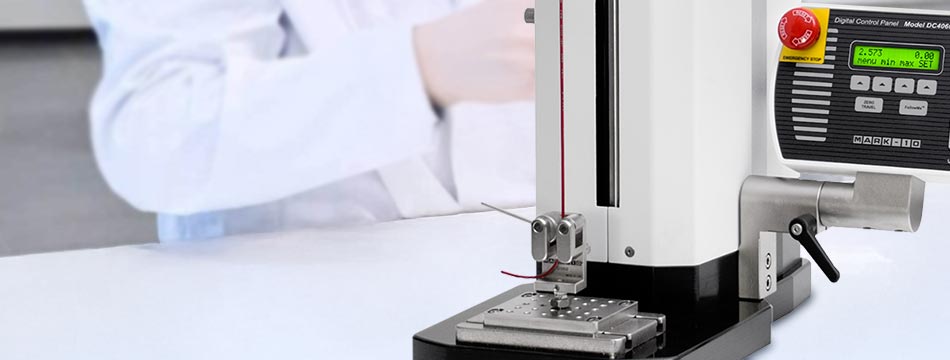
Wire crimp pull, spring, and fastener torque testing are just some of the checks critical to ensuring passenger safety and aircraft performance. Mark-10’s force/ torque instruments and test stands are used by a multitude of airlines, militaries, component manufacturers, and aircraft assemblers to carry out key tests and ensure compliance with internal and international standards.
Quick Links
- Mark 10
- Spring Testing
- Wire Terminal Crimp Pull Testing
- Force & Torque Testing of Dials & Switches
- Passenger Control Button Activation Force
- Bearing Torque Testing
- Cable Tension Testing
- Tensile Strength of Materials
- Bend Strength of Materials
- Electronics Component Pull-Off Testing
- Seat Belt Release Force
- Further Information
Mark-10
Founded in 1979, Mark-10 is a leading USA manufacturer of force and torque measurement instruments. A focus on engineering and innovation has enabled Mark-10 to develop solutions specific to applications across the automotive, medical, textile, pharmaceutical, cosmetic, and food and drinks industries. Mark-10’s force gauges, torque testers, and test stands can be used to ensure safe and optimal aircraft performance: they are pivotal to assessing the properties and durability of components used in every aspect of aerospace technology. To this end, Mark-10's instruments are suitable for carrying out the following tests.
Spring Testing
Spring testing is essential to ensuring that pistons in brake units extend and contract correctly.
Wire Terminal Crimp Pull Testing
Wire harnesses are ubiquitous within the aerospace industry. They are used in aircraft fuselages, avionics, engines, ground support equipment, and other products. It is therefore vital to the safety of pilots, aircraft staff, and passengers that they function correctly. Particularly, that their crimped wire terminals do not become disconnected after the final installation. Mark-10’s Wire Crimp Pull Testers, such as the WT3-201MU Motorised Wire Crimp Pull Tester or WT3-201 Manual Wire Crimp Pull Tester, can be used to ascertain the force required to remove the terminal from the wire, enabling you to assess whether the wire harness is suitable for the application.
Force & Torque Testing of Dials & Switches
Check the torque of rotary switches and dials used in cockpits, lighting, and in-flight entertainment systems, and measure the force required to turn these controls.
Passenger Control Button Activation Force
Similarly, verify the force required to activate passenger control buttons
Mark-10’s M5i Advanced and M7i Professional Force/ Torque Gauges are ideal for a range of tension and compression force measurements.
Bearing Torque Testing
Use Mark-10’s force/torque gauges and test stands to ascertain the performance of bearings by measuring friction torque.
Cable Tension Testing
Ensure that cables meet the demands of aerospace applications by using Mark-10’s test stands and force/ torque gauges to determine the force required to break the cable.
Tensile Strength of Materials
Likewise, Mark-10 products can be used to quantify the force needed to bring aircraft materials to breaking point. Check the tensile strength of:
- Adhesive bonds
- Aircraft textiles and carpets
- Cables, hoses, and tubing
- Gaskets and o-rings
- Parachute materials and cords
- Seat belt materials
- Welded joints
- Wiring looms and harnesses
Bend Strength of Materials
Evaluate the bending properties of materials. For instance, ascertain a material’s bending strength and/or the maximum angle to which it can be bent before reaching breaking point.
Mark-10’s ESM303U Motorised Tension/ Compression Test Stand and ES20 Hand Wheel Operated Test Stand are ideal for conducting crucial tension, compression, push, and pull tests.
Electronics Component Pull-off Testing
Ensure that PCB (Printed Circuit Boards) will function correctly by measuring the strength required to peel the laminate from the board and/or pull off components.
Mark-10’s force/torque gauges and test stands also find applications within the food industry, as similar tests are performed to determine the strength required to remove lids, tabs, handles, and bottle caps.
>> Read more: Mark-10: Food & Beverage Package Testing
Seat Belt Release Force
Measure the force required to release a seat belt. As with bottle caps, the force required must not be so great that the passenger injures themselves while releasing the belt but must not be so minimal that the seat belt comes undone during turbulence.
Further Information
Please browse our collection of Mark-10 products. For further information regarding any of these instruments and their applications or for more details on additional/ unlisted Mark-10 solutions, please contact our Sales team on 01642 931 329 or via our online form.

Footnotes
The information in this blog was gathered using the following sources:
- Eland Cables, Tensile & Elongation Measurement for Cable Insulation Materials, last accessed 14 July 2021
- GOM, Bending test: Suitable for both brittle and ductile materials, last accessed 14 July 2021
- Instron, What is Bend Testing?, last accessed 14 July 2021
- Mark-10, Aerospace, last accessed 14 July 2021
- Mark Fridman, ‘Wire Crimp Pull Testing in the Aerospace Industry’, in Quality Magazine, last accessed 14 July 2021
- Matric Group, 7 PCB Testing Methods You Need to Know, last accessed 14 July 2021
- Mecmesin, Aerospace, last accessed 14 July 2021
- Mecmesin, Aircraft Brake Unit Spring Testing, last accessed 14 July 2021
- Presto, Measuring Tensile Strength of Cables And Wires, last accessed 14 July 2021
- Testometric, Spring Testing, last accessed 14 July 2021


